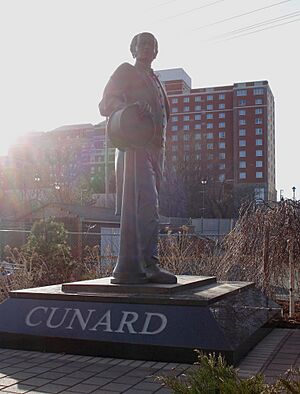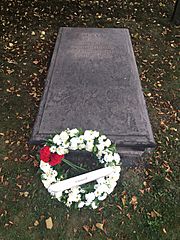Samuel Cunard facts for kids
Quick facts for kids
Samuel Cunard
Bt
|
|
|---|---|
 |
|
| Born | 21 November 1787 |
| Died | 28 April 1865 (aged 77) Kensington, London, England
|
| Occupation | Shipping magnate |
| Spouse(s) |
Susan Duffus
(m. 1815; died 1828) |
| Children | 9 |
| Parent(s) | Abraham Cunard Margaret Murphy |
Sir Samuel Cunard (born November 21, 1787 – died April 28, 1865) was an important British-Canadian businessman. He was born in Halifax, Nova Scotia. Samuel Cunard started the famous Cunard Line, which was the first company to offer regular steamship trips across the Atlantic Ocean to North America. His father was a skilled carpenter and timber merchant who moved to Halifax after the American Revolution.
Contents
Samuel Cunard's Early Life and Family
Samuel Cunard was the second son of Abraham Cunard and Margaret Murphy. His family, the Cunards, were Quakers, a religious group. They had moved from Britain to Germany and then to Pennsylvania in America because of their beliefs.
Samuel's grandfather, Abraham Cunard, was loyal to the British Crown during the American Revolution. He moved to Halifax, Nova Scotia in 1783. There, he married Margaret Murphy, who also moved from America.
Abraham Cunard was a master carpenter. He worked for the British army in Halifax and became a wealthy landowner and timber merchant. Samuel showed his business skills very early. As a teenager, he managed his own general store. Later, he joined his father's timber business, and they also started investing in shipping.
Samuel Cunard's Career and Businesses
During the War of 1812, Samuel Cunard joined the local army group, the 2nd Battalion of the Halifax Regiment. He became a captain. He also held many public jobs, like being a volunteer firefighter. People knew him as a smart businessman who was also honest and generous.
Cunard was a very successful businessman in Halifax. He was one of the most important people in Nova Scotia. He won contracts to deliver mail and provided a ship to patrol for fishing. He expanded his family's timber and shipping business into other areas. These included whaling, importing tea, and coal mining. He also invested in the Halifax Banking Company.
Starting with Steamships

Cunard was careful when he first started using steam power. He helped create the Halifax Steamboat Company. This company built Nova Scotia's first steamship in 1830, called the SS Sir Charles Ogle. It was used for the Halifax–Dartmouth Ferry Service and worked well for many years.
In 1836, Cunard became the president of the company. He arranged for their second ferry, Boxer, to use steam power in 1838. Cunard also led investors from Halifax to work with businesses in Quebec in 1831. They built a pioneering ocean steamship, the Royal William. This ship was meant to travel between Quebec and Halifax. Even though Royal William faced problems, Cunard learned a lot about how steamships work.
His experience with steamships made him think about creating a fleet of steamships that could cross the Atlantic Ocean regularly. He wanted them to travel as reliably as trains crossed land. In 1837, he went to the United Kingdom to find people to invest in his idea. He started a company with other businessmen to bid for a contract to deliver mail across the Atlantic. They won the bid, and their company later became Cunard Steamships Limited.
The Famous Cunard Line
In 1840, the company's first steamship, the Britannia, sailed from Liverpool to Halifax, Nova Scotia, and then to Boston, Massachusetts. Samuel Cunard was on board with 63 other passengers. This trip marked the beginning of regular passenger and cargo service across the Atlantic.
Cunard's company quickly became known for its speed and safety. Many other companies tried to compete, but they often lost ships and money. Cunard's ships were successful, but they were also very expensive. By 1842, Cunard had a lot of debt. He even had to move to England to avoid people he owed money to in Halifax. However, by 1843, his ships were earning enough money to pay off his debts.
Cunard spent his time between Nova Scotia and England. But as his business grew in London, he left his operations in Nova Scotia to his sons, Edward and William.
Samuel Cunard's Views on Fairness
Samuel Cunard was not a very religious person. His thoughts on slavery in the 1800s are not fully known. However, he made a strong statement in 1845 about Frederick Douglass, a famous anti-slavery speaker. Douglass had faced unfair treatment on one of Cunard's ships. Cunard said, "No one can regret more than I do the unpleasant circumstances surrounding Mr. Douglass's passage from Liverpool, but I can assure you that nothing of the kind will again take place on the steamships in which I am connected." This shows he was against any form of unfair treatment based on race.
Later Life and Legacy
Samuel Cunard owned several companies in Canada. After he died, and changes were made to the British mail contract, his partners in England stopped the Canadian service. It took 50 years for his ships to return to Canada. His coal company in Nova Scotia, which he bought to fuel his ships, remained a major family investment. It continued into the 20th century as Cunard Fuels.
In 1859, Queen Victoria made Cunard a baronet. This is a special title of honor.
Sir Samuel Cunard died in Kensington, London, on April 28, 1865. He is buried at Brompton Cemetery in London.
Cunard's Lasting Impact
At the Maritime Museum of the Atlantic in Halifax, a large part of the second floor is about Samuel Cunard's life. It also features the Cunard Line and its famous ships. A big bronze statue of Samuel Cunard was put up in October 2006 on the Halifax Boardwalk. This is near the wharves that Cunard's ships used for a long time. Canada Post even issued a stamp with Cunard's picture in 2004.
Despite challenges from other companies and new technologies, the Cunard company grew. It eventually took over many other shipping lines. In 1934, it even absorbed its main competitor, the White Star Line. The White Star Line owned the successful RMS Olympic and was the former owner of the famous but unlucky Titanic.
After that, Cunard became the leader in Atlantic passenger travel. They had some of the world's most famous liners, like the RMS Queen Mary and RMS Queen Elizabeth. Samuel Cunard's name lives on today in the Cunard Line. It is now a respected part of the Carnival Line cruise company.
Samuel Cunard's Family
Samuel Cunard married Susan Duffus on February 4, 1815. She passed away on February 28, 1828. They had nine children together: two sons (Edward and William) and seven daughters (Mary, Susan, Margaret Ann, Sarah Jane, Ann Elizabeth, Isabella, and Elizabeth).
His oldest son, Sir Edward Cunard, 2nd baronet, took over both the business and the baronetcy. Edward's son, Bache Edward Cunard, married the well-known society hostess Emerald, Lady Cunard. They had one daughter, Nancy Cunard, who became a writer and activist.
William Cunard, Samuel's second son, married Laura Charlotte Haliburton. She was the daughter of the author and politician Thomas Chandler Haliburton. William built the Halifax School for the Deaf. Samuel Cunard's daughter Margaret married William Leigh Mellish, who was a soldier and cricketer.



